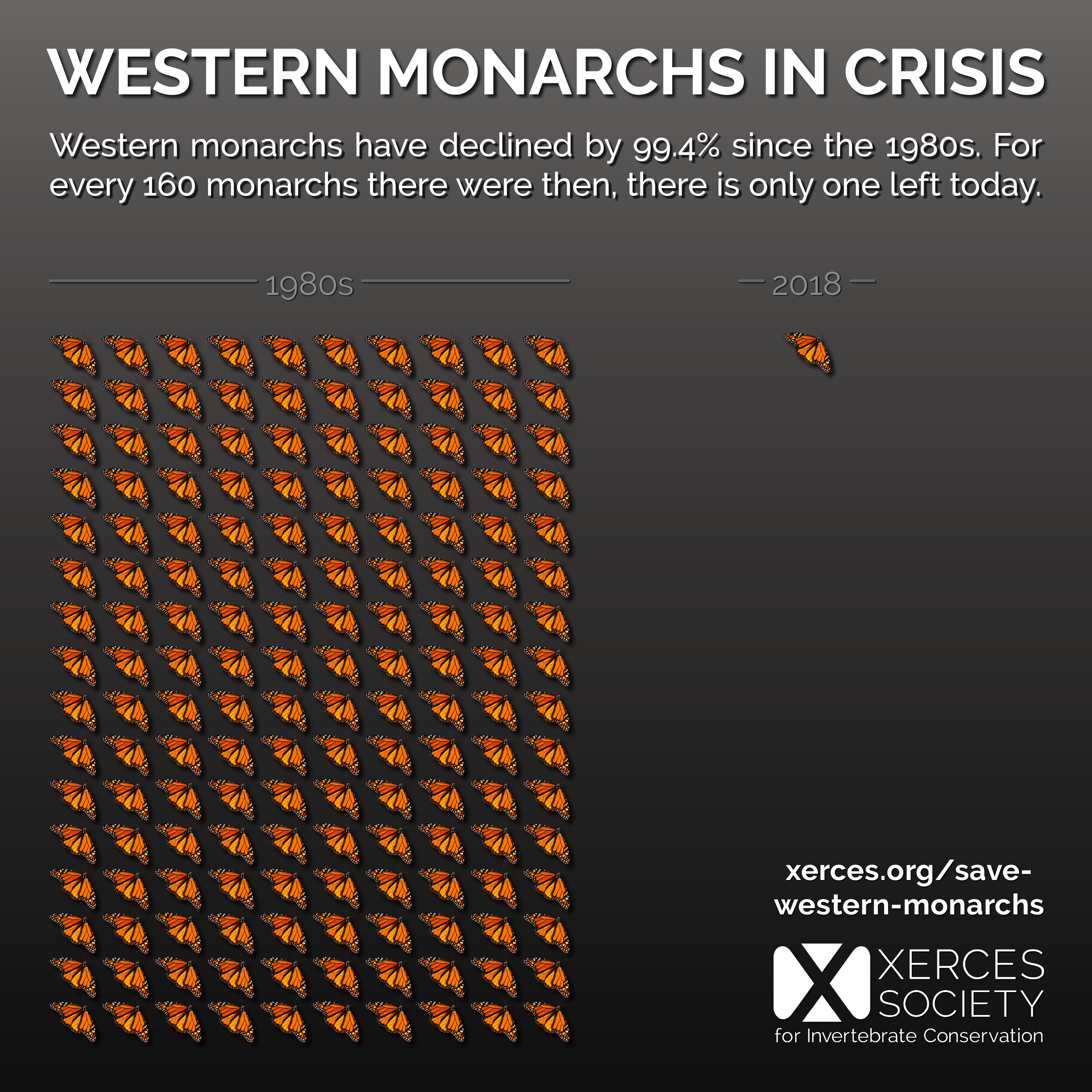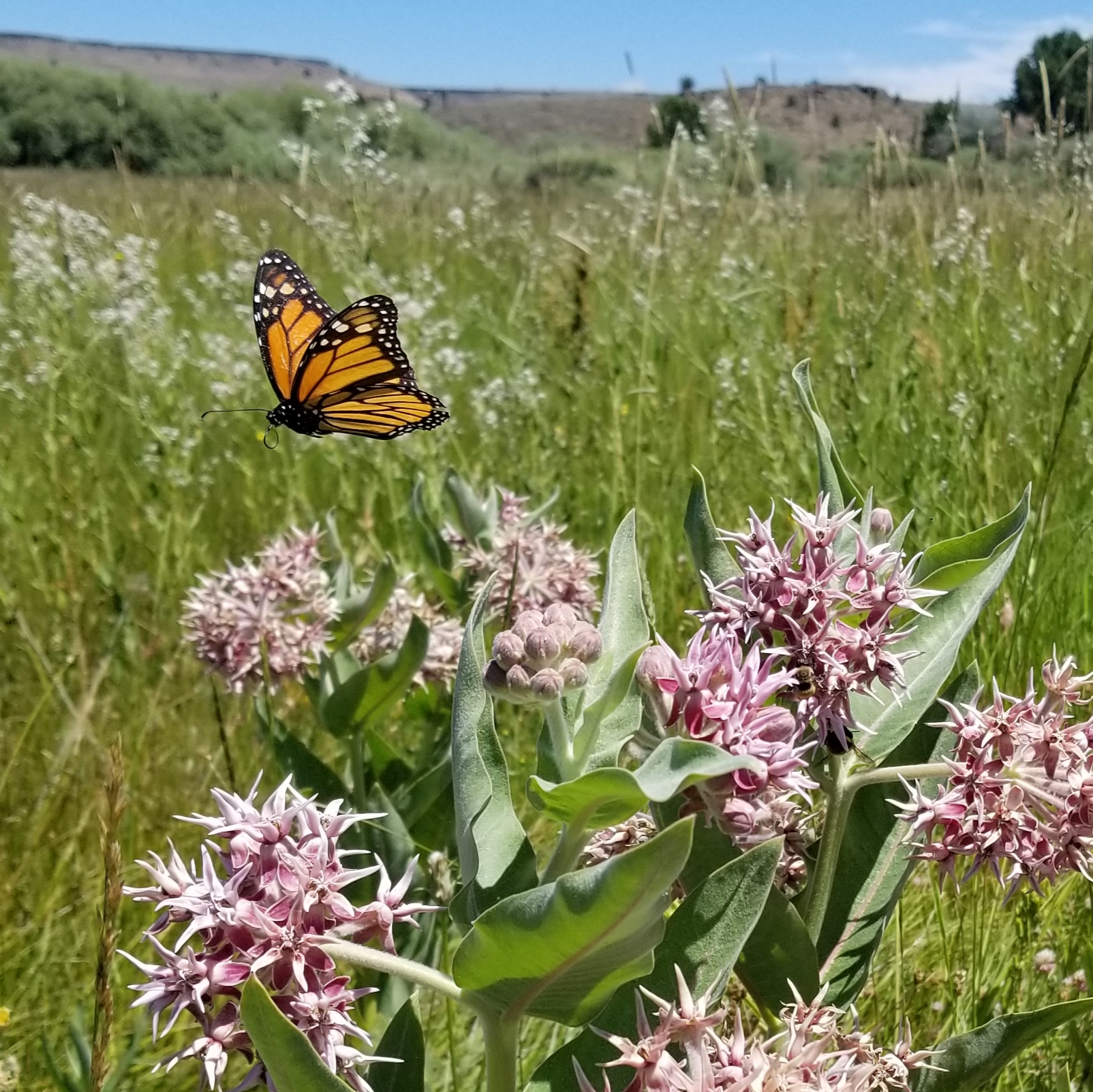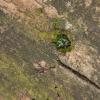While hiking in California and the rest of the West, you can help researchers by submitting any and all monarch and milkweed observations this year to the Western Monarch Milkweed Mapper website.
This winter, the western monarch butterfly population has dipped to an all-time low, and the iconic western monarch migration is on the verge of collapse. The annual Xerces Society Western Monarch Thanksgiving Count tallied only 28,429 butterflies—an 86% drop from the previous count done at the same sites during Thanksgiving 2017, and a dizzying 99.4% decline from the numbers present in the 1980s. It can be hard to wrap one’s mind around the scope of this decline. Another way of viewing it is that for every 160 monarch butterflies there were in the 1980s, there is only one left today.

In response to this steep decline, the Xerces Society released a Call to Action in January, outlining ways we can all help the imperiled western monarch. In addition, the abrupt decline this year has spurred a National Science Foundation RAPID research project by researchers and biologists from Washington State University, Tufts University, University of California-Santa Cruz, and the Xerces Society. The research project aims to study the population at this critically low population level. Data collected now will allow researchers to understand underlying mechanisms of the decline, to better understand how the population fluctuates, and how to respond to this situation effectively.
For example, if the population rebounds this coming year, we will focus on management to restore habitat and mitigate other causes of long-term declines. If monarchs have low survival or reproduction when populations become very small, we may need to add further management activities to make up for the consequences of this recent crash, as well as addressing the drivers of long-term declines. In short, the information collected during this time will help to guide critical monarch conservation efforts in the West.
To accomplish this, researchers are asking for people to report any and all observations of monarchs and milkweed in California, as well as all other western states. In particular, researchers need to know where monarchs go after they leave overwintering sites on the California Coast, which is happening right now (February-March), as well as if any native milkweed has emerged and is available for monarchs to lay eggs on at this time. This will help researchers better understand:
- What habitat is important for monarchs when they leave overwintering sites,
- How quickly the western population expands throughout the west this year (the lowest population ever recorded) compared to previous years, and
- If the population is able to rebound from such low overwintering numbers.
Although this research has the potential to make a big impact, the data can be collected and submitted easily, by anyone, regardless of their background. Any and everyone is welcome to take part!
In this case, all you need to do is snap a photo and note the latitude and longitude, and you will be contributing to science to help us better understand ways to recover the iconic western monarch migration. We encourage everyone to take some time while hiking in the California coast range, California Central Valley, and the rest of the West, to help researchers by submitting any and all monarch and milkweed observations this year to the Western Monarch Milkweed Mapper website. (More details are noted below.)

The information collected by this project will be invaluable to researchers, biologists, land managers, naturalists, and the general public that wishes to see the iconic western monarch migration continue for generations to come. The mapper is also a great tool to find existing milkweed populations near you to survey this spring for monarchs and milkweed phenology (when and where milkweed grows, flowers, and produces seed).
Thank you for taking the time to search for monarchs and milkweeds this spring and for contributing invaluable scientific data to researchers!
How to Submit Data:
iPhone:
Download the free Monarch SOS app from the App Store, and follow the instructions!
Android and Windows devices:
These are, unfortunately, not supported at this time by the Monarch SOS app. If you have a device that isn’t supported, you will need to collect the following data and then submit it to the Western Monarch Milkweed Mapper website:
- Snap a photo of a milkweed plant or any stage of a monarch butterfly (eggs, larvae, pupae, or adults).
- Record location information (latitude, longitude).
- Record relevant information for milkweed: number of milkweed plants, whether the plants are flowering or fruiting, a, mating or egg laying and if the plants have any monarch eggs, larvae or pupae on them.
- Identify milkweeds using the milkweed key, which profiles over 40 milkweed species found in the West.
- Record relevant monarch information: behavior such as nectaring, mating, egg laying as well as the total number of monarchs observed.
- Use resources on the website to properly identify monarch butterflies and each of the life stages (egg, larvae, pupae, adult).
- Submit the data via the Western Monarch Milkweed Mapper website.
More Information on the Data Needed for the Western Monarch Milkweed Mapper:
Monarch Butterfly Data:
- Report specific behaviors such as mating monarch pairs, egg laying, breeding, and adult monarchs nectaring—and what species of flowers they are nectaring on.
- Any and all monarch observations in California this spring (beginning in February).
- Any and all monarch observations throughout the rest of the West for the entire year (including Arizona, Idaho, Oregon, Montana, Nevada, New Mexico, Utah, Washington, and Wyoming).
Milkweed Data:
- Early emerging milkweed phenology data in the California Coast Range, Central Valley, and Sierra foothills, and the desert regions in southeastern California.
Specifically researchers are keen to learn when the earliest milkweed species emerge in California. The species to look for now (February-April) include: California milkweed (Asclepias californica), woollypod milkweed (A. eriocarpa), heartleaf milkweed (A. cordifolia), and narrowleaf milkweed (A. fascicularis), a species that has been observed growing nearly year-round in areas from Santa Barbara County to San Diego County on the California Coast.
- General milkweed phenology for the rest of the West.
Report any and all milkweed data for the rest of the West. Pay close attention to and report when milkweed emerges first in your region and report it to the Western Monarch Milkweed Mapper.
Further Reading
Western Monarch Call to Action.
Read our blog post announcing the record low monarch numbers, measured in winter 2018-2019.
Learn more about the Xerces Society’s monarch conservation work.



